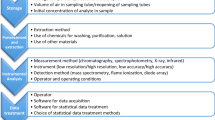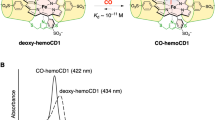Abstract
The measure of hemolysis in humans is clinically important. Here we describe methods using a gas chromatograph equipped with a reduction gas detector to detect the human analyte carbon monoxide (CO) that were developed for the extreme environment of the International Space Station. These methods can be adapted to in-hospital use for clinical care with characteristics that may surpass existing measures of hemolysis. We demonstrate improved performance over previous-generation methods in terms of reproducibility, accuracy, control for physical and intervening factors to quantitatively assess hemolysis rates at unprecedented levels. The presented measure of hemolysis using CO elimination is based on a different physiological approach that can complement and augment existing detection tools. In addition to their suitability for extreme environments, the methods present distinctive advantages over existing markers for the diagnosis, monitoring and response to treatment of hemolytic anemia. These methods have the potential to fulfill a wide range of research and clinical applications.







Similar content being viewed by others
Abbreviations
- CO:
-
Carbon monoxide
- RBC:
-
Red blood cell
- Hb:
-
Hemoglobin
- EC:
-
Electrochemical
- MSD:
-
Mass spectroscopic detection
- GC:
-
Gas chromatography
- RGD:
-
Reduction gas detection
- ppb:
-
Parts per billion
- ISS:
-
International Space Station
- SS:
-
Stainless steel
- Micro-QT valve:
-
Micro-QT™ Valve to Luer-Lok w/Silonite™, Entech Instruments
- BTPS:
-
Body temperature pressure saturated
References
American Academy of Pediatrics Subcommittee on Hyperbilirubinemia. Management of hyperbilirubinemia in the newborn infant 35 or more weeks of gestation. Pediatrics 114:297–316, 2004.
Ametek TA3000R. AMETEK Process Instruments, Ametek Inc., pp. 1–4, 2004. http://pdf.directindustry.com/pdf/ametek-process-instruments/ta3000/14271-744425.html. Accessed 7 Nov 2018.
Barcellini, W., and B. Fattizzo. Clinical applications of hemolytic markers in the differential diagnosis and management of hemolytic anemia. Dis. Markers 2015:635670, 2015.
Berlin, N. I. Diagnosis and classification of the polycythemias. Semin. Hematol. 12:339–351, 1975.
Capnia CoSense ETCO Monitor. http://www.capnia.com/products/cosense-overview/. Accessed 7 Nov 2018.
Castillo Cuadrado, M. E., V. K. Bhutani, J. L. Aby, H. J. Vreman, R. J. Wong, and D. K. Stevenson. Evaluation of a new end-tidal carbon monoxide monitor from the bench to the bedside. Acta Paediatr. 104:e279–e282, 2015.
Coburn, R. F. Endogenous carbon monoxide production. N. Engl. J. Med. 282:207–209, 1970.
Coburn, R. F. The measurement of endogenous carbon monoxide production. J. Appl. Physiol. 112:1949–1955, 2012.
Damulewicz, M., A. Loboda, A. Jozkowicz, J. Dulak, and E. Pyza. Interactions between the circadian clock and heme oxygenase in the retina of Drosophila melanogaster. Mol. Neurobiol. 54:4953–4962, 2017.
Dean, L. The ABO blood group. In: Blood Groups and Red Cell Antigens. Bethesda: National Center for Biotechnology Information (US), 2005.
Dubert, M., J. Elion, A. Tolo, D. A. Diallo, S. Diop, I. Diagne, et al. Degree of anemia, indirect markers of hemolysis, and vascular complications of sickle cell disease in Africa. Blood 130:2215–2223, 2017.
EURACHEM. Quantifying Uncertainty in Analytical Measurement (2nd ed.). Helsinki: EURACHEM/CITAC Working Group, 2000.
Föller, M., S. M. Huber, and F. Lang. Erythrocyte programmed cell death. IUBMB Life 60:661–668, 2008.
Fowler, W. S. Lung function studies; the respiratory dead space. Am. J. Physiol. 154:405–416, 1948.
Ghorbani, R., A. Blomberg, and F. M. Schmidt. Modeling pulmonary gas exchange and single-exhalation profiles of carbon monoxide. Front. Physiol. 9:927, 2018.
Ghorbani, R., and F. M. Schmidt. Fitting of single-exhalation profiles using a pulmonary gas exchange model-application to carbon monoxide. J. Breath Res. 13:026001, 2019.
Hall, J. E. Guyton and Hall Textbook of Medical Physiology (13th ed.). Philadelphia: Elsevier, 2016.
Hampson, N. B. Carboxyhemoglobin elevation due to hemolytic anemia. J. Emerg. Med. 33:17–19, 2007.
Handin, R., S. E. Lux, and T. P. Stossel. Blood: Principles and Practice of Hematology. Philadelphia: Lippincott Williams & Wilkins, 2003.
Kaasik, K., and C. C. Lee. Reciprocal regulation of haem biosynthesis and the circadian clock in mammals. Nature 430:467–471, 2004.
Kato, G. J., V. McGowan, R. F. Machado, J. A. Little, J. Taylor, C. R. Morris, et al. Lactate dehydrogenase as a biomarker of hemolysis-associated nitric oxide resistance, priapism, leg ulceration, pulmonary hypertension, and death in patients with sickle cell disease. Blood 107:2279–2285, 2006.
Klemz, R., S. Reischl, T. Wallach, N. Witte, K. Jürchott, S. Klemz, et al. Reciprocal regulation of carbon monoxide metabolism and the circadian clock. Nat. Struct. Mol. Biol. 24:15–22, 2017.
Knutson, M., and M. Wessling-Resnick. Iron metabolism in the reticuloendothelial system. Crit. Rev. Biochem. Mol. Biol. 38:61–88, 2003.
Ku, H. H. Notes on the use of propagation of error formulas. J. Res. Natl Bur. Stand. 70C(4):262, 1966.
Landaw, S. A., E. W. Callahan, and R. Schmid. Catabolism of heme in vivo: comparison of the simultaneous production of bilirubin and carbon monoxide. J. Clin. Investig. 49:914–925, 1970.
Levitt, D. G., and M. D. Levitt. Carbon monoxide: a critical quantitative analysis and review of the extent and limitations of its second messenger function. Clin. Pharmacol. 7:37–56, 2015.
Marks, G. S., H. J. Vreman, B. E. McLaughlin, J. F. Brien, and K. Nakatsu. Measurement of endogenous carbon monoxide formation in biological systems. Antioxid. Redox Signal. 4:271–277, 2002.
Rapido, F., G. M. Brittenham, S. Bandyopadhyay, F. L. Carpia, C. L’Acqua, D. J. McMahon, et al. Prolonged red cell storage before transfusion increases extravascular hemolysis. J. Clin. Investig. 127:375–382, 2017.
Risso, A., A. Ciana, C. Achilli, G. Antonutto, and G. Minetti. Neocytolysis: none, one or many? A reappraisal and future perspectives. Front. Physiol. 5:54, 2014.
Steinberg, M. H. Sickle cell anemia, the first molecular disease: overview of molecular etiology, pathophysiology, and therapeutic approaches. Sci. World J. 8:1295–1324, 2008.
Tidmarsh, G. F., R. J. Wong, and D. K. Stevenson. End-tidal carbon monoxide and hemolysis. J. Perinatol. 34:577–581, 2014.
Tracz, M. J., J. Alam, and K. A. Nath. Physiology and pathophysiology of heme: implications for kidney disease. J. Am. Soc. Nephrol. 18:414–420, 2007.
Vreman, H. J., D. K. Stevenson, W. Oh, A. A. Fanaroff, L. L. Wright, J. A. Lemons, et al. Semiportable electrochemical instrument for determining carbon monoxide in breath. Clin. Chem. 40:1927–1933, 1994.
Yao, L., Z. Liu, J. Zhu, B. Li, C. Chai, and Y. Tian. Higher serum level of myoglobin could predict more severity and poor outcome for patients with sepsis. Am. J. Emerg. Med. 34(6):948–952, 2016.
Acknowledgments
We thank Doug Worthy and Michele Rauh from the Canadian Green House Gases program, Kate Culliton, Theresa Backlund, Odette Laneuville for experimentation with the methods described. This work was supported in part by Canadian Space Agency through Contracts and Grant Numbers 9F053-100597, 9F008-140254 and 15EXPBEDST.
Conflict of interest
The authors declare no conflict of interests.
Author information
Authors and Affiliations
Corresponding author
Additional information
Associate Editor Emmanuel Opara oversaw the review of this article.
Publisher's Note
Springer Nature remains neutral with regard to jurisdictional claims in published maps and institutional affiliations.
Electronic supplementary material
Below is the link to the electronic supplementary material.
Rights and permissions
About this article
Cite this article
Shahin, N., Louati, H. & Trudel, G. Measuring Human Hemolysis Clinically and in Extreme Environments Using Endogenous Carbon Monoxide Elimination. Ann Biomed Eng 48, 1540–1550 (2020). https://doi.org/10.1007/s10439-020-02473-5
Received:
Accepted:
Published:
Issue Date:
DOI: https://doi.org/10.1007/s10439-020-02473-5




